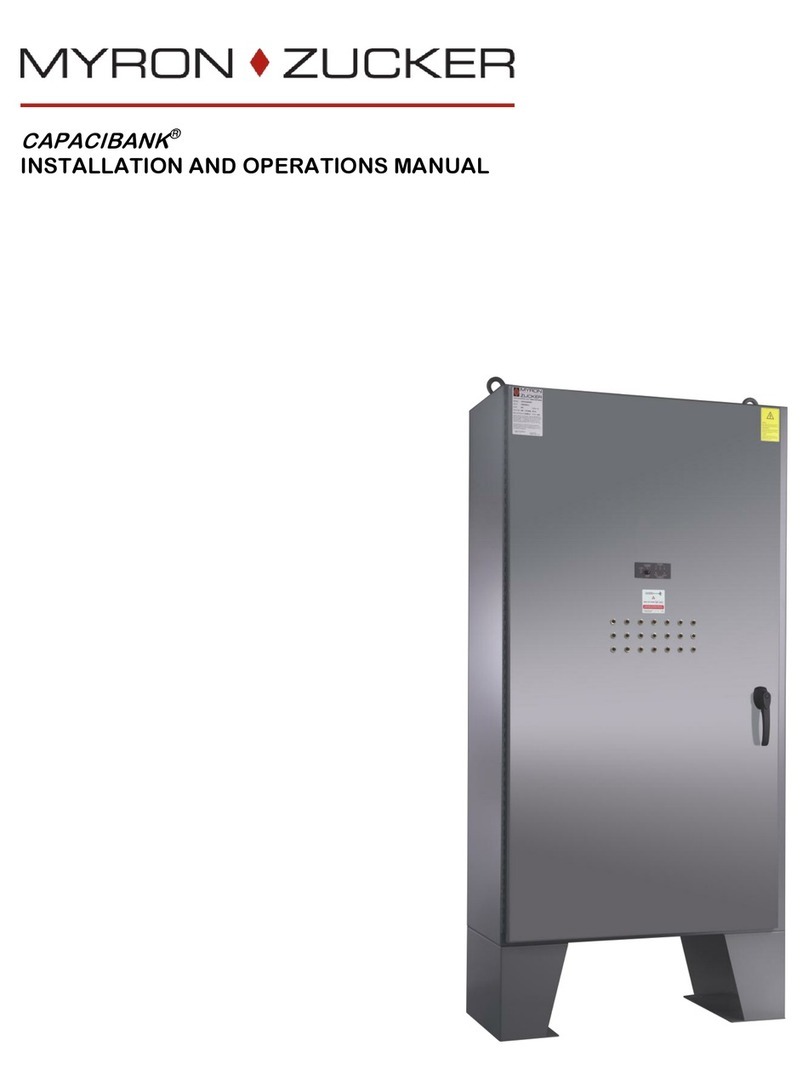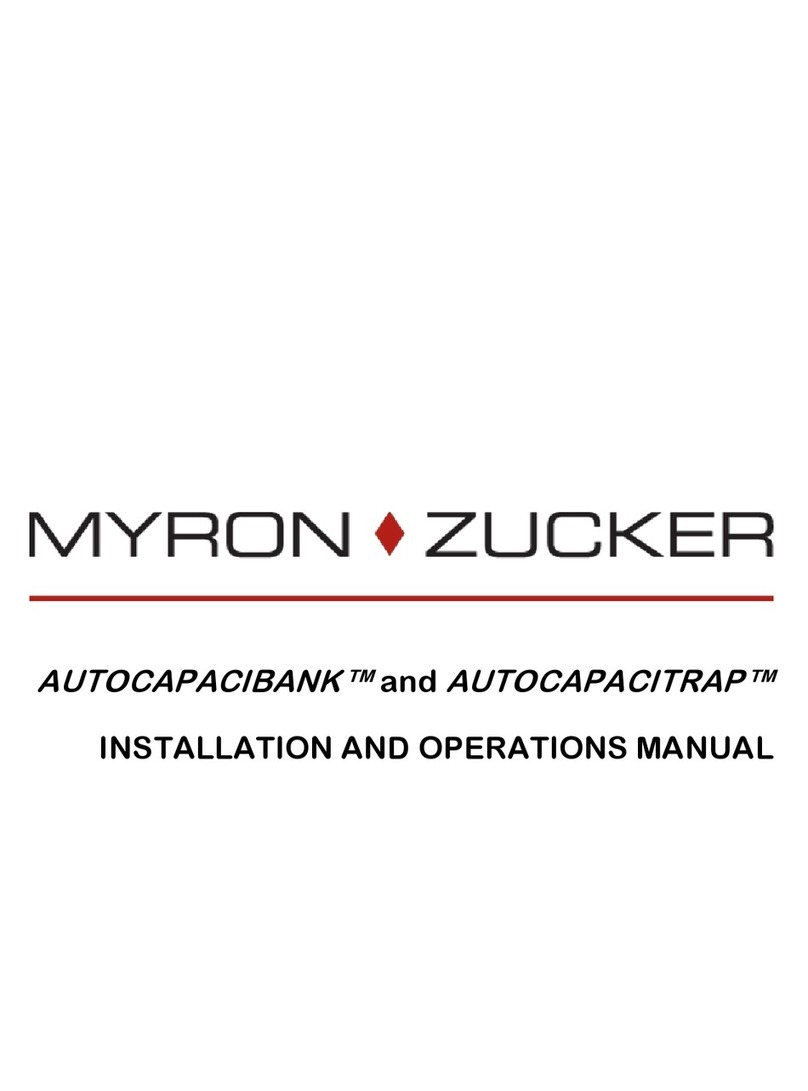MYRON ZUCKER CALTRAP User manual

CALTRAP
™
INSTALLATION AND OPERATIONS MANUAL

CALTRAP™
Installation and Operations Manual
NOTE Please read this entire installation and operations manual before energizing the
CALTRAP™.
Safety Considerations:
Installing and servicing capacitor equipment can be hazardous. Only trained personnel
should install and service power factor correction capacitors.
Observe precautions in the literature, on tags, and on labels attached to the unit.
Follow all safety codes such as Lock-out/Tag-out procedures, Arc Flash safety, etc.
Wear required Personal Protective Equipment (PPE) such as safety glasses, work
gloves, cotton clothing, etc. as required by local code and safety procedures.
Warnings and Cautions:
Failure to read these instructions and failure to install the equipment per instructions
may cause equipment damage and may void the warranty.
Care should be taken in keeping the inside of enclosures clear of any debris,
metalworking by-products or electrician’s tools.
It is recommended that incoming power be disconnected at the source before making
any electrical or mechanical connections, changes or hands-on inspections.
To de-energize capacitor cells, wait one minute after disconnecting the unit from the
primary circuit to allow capacitor discharge resistors to reduce capacitor voltage to less
than 50 volts (National Electrical Code, Article 460-6 requirement).

CALTRAP™
Installation and Operations Manual
TABLE OF CONTENTS
1. PRE-INSTALLATION ....................................................................................... 1
1.1 Storage ............................................................................................... 1
1.2 Location ............................................................................................. 1
2. POWER SOURCE ............................................................................................ 2
2.1 Voltage ............................................................................................... 2
2.2 Conductor (Wire) Size ....................................................................... 2
2.3 Disconnect Devices and Ratings ....................................................... 2
2.4 Connections to Power Source ........................................................... 2
2.5 Equipment Ground ............................................................................. 2
3. REMOTE CONTROL ........................................................................................ 3
4. PREVENTATIVE MAINTENANCE PROCEDURES ........................................ 4
TABLES AND FIGURES
TABLE 1. Recommended Wire Sizes, Switches And Fuses............................ 3
FIGURE 1. Connection to Power Source Diagram .......................................... 2

CALTRAP™
Installation and Operations Manual
1
1. PRE-INSTALLATION Inspect the unit for any damage as soon as it is received. All risk of loss or damage
in transit shall pass to the purchaser at the shipping point, regardless of freight
payment.
Check that all packages and/or crates have been delivered and that the
equipment has not been damaged in transit.
Forward any claims to the carrier immediately (most carriers impose a 24-hour
time limit for the reporting of loss or damage).
Damaged or missing items are the responsibility of the carrier and must be
reported.
Check that the information shown on the equipment nameplates corresponds
with the order specifications.
The packaging material should be replaced for protection until installation has
begun.
1.1 Storage
If the unit cannot be placed into service reasonably soon after its receipt, it should
be stored in a clean, dry and ventilated building free from temperature extremes.
Acceptable storage temperatures are from 0°C (32°F) to 40°C (104°F).
Store the equipment in a dry, ventilated location, sheltered from rain, water
spray, splashes and chemicals.
Stored equipment should be protected by a tarp or other cover providing
effective protection against dust, dirt, paint, etc.
1.2 Location
Installation ambient temperatures are very important to achieve design life of
equipment.
Suggested location maximum ambient temperature is 40°C (104°F).
Maximum capacitor operating ambient temperature shall be 46°C (115°F).
For outdoor enclosures, care must be taken to keep unit from direct sunlight
and other weather conditions.
Spacing from walls shall be six (6) inches and twelve (12) inches from
overheads. All other equipment, housings, cabinets or other obstructions shall
be considered as walls or overheads.

CALTRAP™
Installation and Operations Manual
2
2. POWER SOURCE 2.1 Voltage
Check the unit’s nameplate to make certain that the voltage rating is suitable for
operation at the supply (line) voltage. These units are capable of operation at a
maximum of 110% of nameplate rated voltage (RMS, 50 or 60 Hz).
2.2 Conductor (Wire) Size
See TABLE 1 on next page for recommended wire size.
2.3 Disconnect Devices and Ratings
Equipment shall be capable of being disconnected from power source with switch,
fuse switch or circuit breaker. See TABLE 1 for recommended current ratings.
2.4 Connections to Power Source
Equipment shall be connected to power source as shown in FIGURE 1.
FIGURE 1
CONNECTION TO POWER SOURCE DIAGRAM
Connecting the Caltrap™to the drive terminal and also adding a disconnect is the
best way to connect your Caltrap™. Not only do you keep harmonic currents from
the drive cables, you also have a means to disconnect the Caltrap™from the drive
circuit. This will allow maintenance, if needed, to the Caltrap™while keeping the
motor system still online. This is particularly important if you cannot shut down
your process any time you might want to –for example, in an injection molding
operation.)
Power leads shall be straight and without kinks or loops. Lead length should be
such that no strain is applied to the power lead connector. Power leads shall be
firmly clamped in connectors by tightening connector bolts. Wire lead strands
should not move in connector when the lead is moved from side to side by hand.
Improper (loose) connections will cause terminal overheating and possible early
failure of the capacitor cells.
2.5 Equipment Ground
All units are provided with ground connector lug(s) within the enclosure to facilitate
grounding per National Electrical Code, Articles 460-10 & 250.
Motor
M
Drive
Disconnect
(optional)
Drive or System
Disconnect
Caltrap™
Table of contents
Other MYRON ZUCKER Industrial Equipment manuals



















